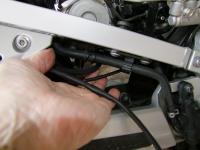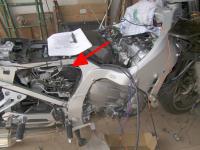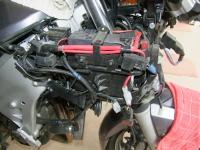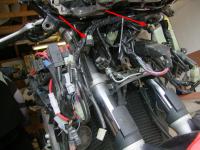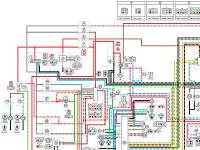Hi All,
I have a 2009 FJR1300 AE and I have been working with Brodie, ionbeam, and Donal (plus reading lots of posts on the forum) to solve electrical problems.
I am currently installing a 10 Guage regulator/rectifier-to-battery wiring harness made by RoadsterCycle.com. I made a temporary install of the harness (running outside the faring and over the tank), and I verified that it solves my voltage drop problem.
I am not sure about the best way to run the 10 gauge wires from the R/R to the battery. I am particularly concerned about whether the wires can be in contact with the engine because of heat, and how to keep the wires clear of the front fork turning radius.
I see two main options:
1. Run the wires along the left side of the bike between the engine and the frame. I think this is where the factory harness runs, but I don't see an easy way to get across to the battery compartment, and I don't see how the factory wires from the R/R get there. I am also concerned about heat from the engine, since the wires can end up being in contact with valve cover.
2. Run the wires along the right side of the bike between the engine and the frame. I see three ways to cross over to the right side of the bike
a. Loop under the R/R and leave the wires hanging loose in the center of the bike.
b. Loop back over the top of the R/R. The R/R will support the wires but exposes them to the substantial heat (about 180 deg F) from the R/R
c. Loop up and run through the area under the seat (where many people mount power blocks). This will involve cutting a hole in the plastic on each side.
Has anybody figured the best way to do this? Is there a link you could refer me to?
Thanks!
I have a 2009 FJR1300 AE and I have been working with Brodie, ionbeam, and Donal (plus reading lots of posts on the forum) to solve electrical problems.
I am currently installing a 10 Guage regulator/rectifier-to-battery wiring harness made by RoadsterCycle.com. I made a temporary install of the harness (running outside the faring and over the tank), and I verified that it solves my voltage drop problem.
I am not sure about the best way to run the 10 gauge wires from the R/R to the battery. I am particularly concerned about whether the wires can be in contact with the engine because of heat, and how to keep the wires clear of the front fork turning radius.
I see two main options:
1. Run the wires along the left side of the bike between the engine and the frame. I think this is where the factory harness runs, but I don't see an easy way to get across to the battery compartment, and I don't see how the factory wires from the R/R get there. I am also concerned about heat from the engine, since the wires can end up being in contact with valve cover.
2. Run the wires along the right side of the bike between the engine and the frame. I see three ways to cross over to the right side of the bike
a. Loop under the R/R and leave the wires hanging loose in the center of the bike.
b. Loop back over the top of the R/R. The R/R will support the wires but exposes them to the substantial heat (about 180 deg F) from the R/R
c. Loop up and run through the area under the seat (where many people mount power blocks). This will involve cutting a hole in the plastic on each side.
Has anybody figured the best way to do this? Is there a link you could refer me to?
Thanks!
Last edited by a moderator:




